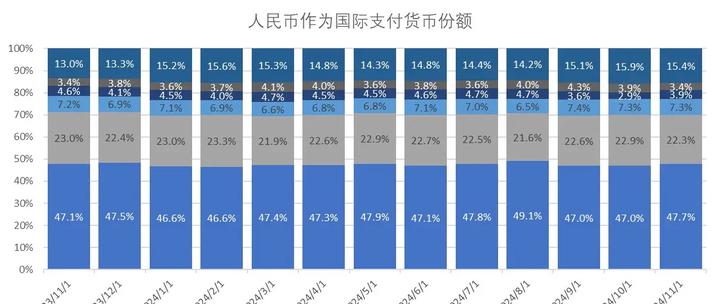RMB Becomes Fourth Most Active Global Currency in International Payments
According to SWIFT data from November 2024, RMB’s share in global payments rose to 3.89%, making it the fourth most active currency globally, surpassing the Japanese Yen. This marks a significant recovery after two months of decline.

The latest SWIFT report reveals an intriguing shift in global currency dynamics, with China’s Renminbi (RMB) claiming the fourth position among the world’s most actively used currencies in international payments. This development merits a deeper analysis of the underlying factors and broader implications.
The current hierarchy of global payment currencies shows a clear tiered structure. The U.S. dollar maintains its dominant position with a 47.68% share, followed by the Euro at 22.29% and the British pound at 7.27%. The RMB’s rise to 3.89% represents a notable achievement, particularly given its recent volatility.
What makes this development particularly significant is the context of RMB’s journey. After experiencing a challenging period in September and October 2024, where its share dropped to 3.61% and 2.93% respectively, November’s recovery demonstrates the currency’s resilience. This fluctuation pattern reflects the complex interplay of various factors affecting international trade and financial flows.
The RMB’s position in global payments is unique due to China’s distinct approach to currency internationalization. Unlike fully convertible currencies such as the USD, EUR, and GBP, the RMB operates under a managed system. China has developed its own Cross-Border Interbank Payment System (CIPS), which complements SWIFT and provides an alternative channel for RMB transactions.
The rise in RMB’s global usage can be attributed to several factors. China’s expanding trade relationships, particularly with countries seeking alternatives to traditional dollar-based transactions, has created new opportunities for RMB-denominated trade. Furthermore, China’s strategic partnerships and bilateral currency swap agreements have enhanced the RMB’s role in international commerce.
Looking beyond the SWIFT statistics, the RMB’s actual global presence might be more substantial. Many bilateral trade arrangements and direct settlement mechanisms operate outside the SWIFT system, suggesting that the currency’s real influence could be underrepresented in these figures.
This ascent of the RMB reflects broader changes in the global economic landscape. While traditional reserve currencies maintain their dominance in international finance, the emergence of alternative payment systems and settlement mechanisms indicates a gradual diversification of global currency usage patterns.
The future trajectory of RMB internationalization will likely depend on several key factors: China’s continued economic development, the evolution of its financial markets, and the broader geopolitical environment. The currency’s growing role in international payments represents just one aspect of its expanding global presence.